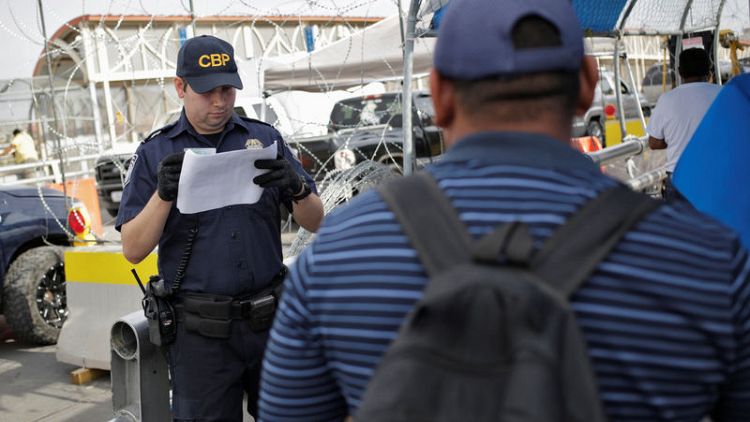By Julia Love
CIUDAD JUAREZ, Mexico (Reuters) - As a new Trump administration policy aimed at making almost all migrants ineligible for asylum at the U.S. southern border spread fear this week, those at the front of the line in Mexican border cities found the gates to the United States were still open, though they will face a much higher bar to stay.
As the policy went into effect on Tuesday, migrants in Ciudad Juarez and other Mexican border towns were cautiously optimistic: U.S. officials were still moving down the list of asylum seekers, calling migrants to cross the bridge into the United States and apply.
The rule requires asylum-seekers who travel through a third country en route to the United States to first pursue safe-haven there, precluding claims for the thousands who travel from Central American countries through Mexico on their way to the U.S. border.
However, Trump's latest crackdown on immigration ahead of his 2020 re-election bid does not change the way asylum seekers are initially processed at the border, the Department of Homeland Security confirmed on Wednesday.
"Aliens subject to the third-country-transit asylum bar will be processed through existing procedures," a DHS spokeswoman who asked not to be named told Reuters.
Migrants could still be granted interviews with U.S. asylum officers or face hearings in front of a U.S. immigration judge but the bar will be much higher for their claims to prosper.
Human rights groups including the American Civil Liberties Union have sued to block the measure, saying it violates U.S. asylum obligations and forces people to remain in countries "rife with danger."
Mexican officials on Tuesday called numbers from the list of several thousand people waiting to apply for asylum in Ciudad Juarez, which borders El Paso, Texas. Ten people were called and crossed over to the United States on Tuesday morning, and another 10 followed in the afternoon, Ciudad Juarez human rights director Rogelio Pinal said.
Some 750 miles away in Tijuana, migrants were called from the list for interviews in San Diego, California, on Tuesday, according to a Reuters witness.
"WHAT WOULD YOU ADVISE?"
Karina Reyes, a 34-year-old from Cuba, paced anxiously outside an immigration office in Ciudad Juarez on Tuesday morning, waiting to see whether she would finally get the chance to seek asylum.
Her journey began in October, when she flew from Cuba to Guyana, which has loose visa requirements for those from the Communist-run island, and slowly made her way north. When she reached Ciudad Juarez in April, she faced a three-month wait to apply for protection in the United States.
“After waiting for so long, we want it to be worth it,” Reyes said between swigs of Diet Coke, saying she had been too nervous to sleep the night before.
Minutes later, she was among the first to be summoned from Ciudad Juarez to the Customs and Border Protection offices across the bridge since the rule came into effect.
Some 10,000 people are waiting in Mexican border towns to make asylum claims, the result of a U.S. practice dubbed "metering" that limits the number of asylum claims at ports of entry per day. Many other asylum seekers cross illegally between ports of entry and hand themselves in to border officials.
News of the policy sparked panic among migrants. In theory, more people are expected to be deported more quickly to their home countries as a result of the new rule.
On Monday night, in the final hours before the new policy came into effect, some migrants considered making a last-ditch attempt to reach the United States, Pinal said.
A steady stream of migrants arrived at the bridge to the United States throughout the evening, mulling whether to cross as a group and ask U.S. officials for asylum, said Pinal, who was at the scene. One young woman, a migrant from Cuba, asked Pinal a question that he said stopped him in his tracks.
“If you were my father, what would you advise me to do?” the woman said through tears, as Pinal recalled.
The woman was in a precarious position. Her husband had reached the United States ahead of her and she had no one in Mexico to help her. Pinal said he advised the woman to try her luck on the bridge - for what might be her last chance at lodging an asylum claim.
The woman heeded his advice but soon turned back, saying that U.S. officials told her that the long list of migrants waiting in Ciudad Juarez would still get their chance to make a claim, Pinal said.
Most of the 40 to 50 migrants who Pinal and other officials counselled at the bridge made the same decision, opting to wait in Mexico. They are likely to face a tougher bar as a result.
Though he does not know how the process will play out, Pinal said he was reassured that U.S. officials continued moving down the list on Tuesday.
“I breathed a big sigh of relief," he said.
(Reporting by Julie Love; Additional reporting by Mica Rosenberg in Washington, Kristina Cooke in San Francisco and Lizbeth Diaz in Tijuana; Editing by Frank Jack Daniel and Leslie Adler)


